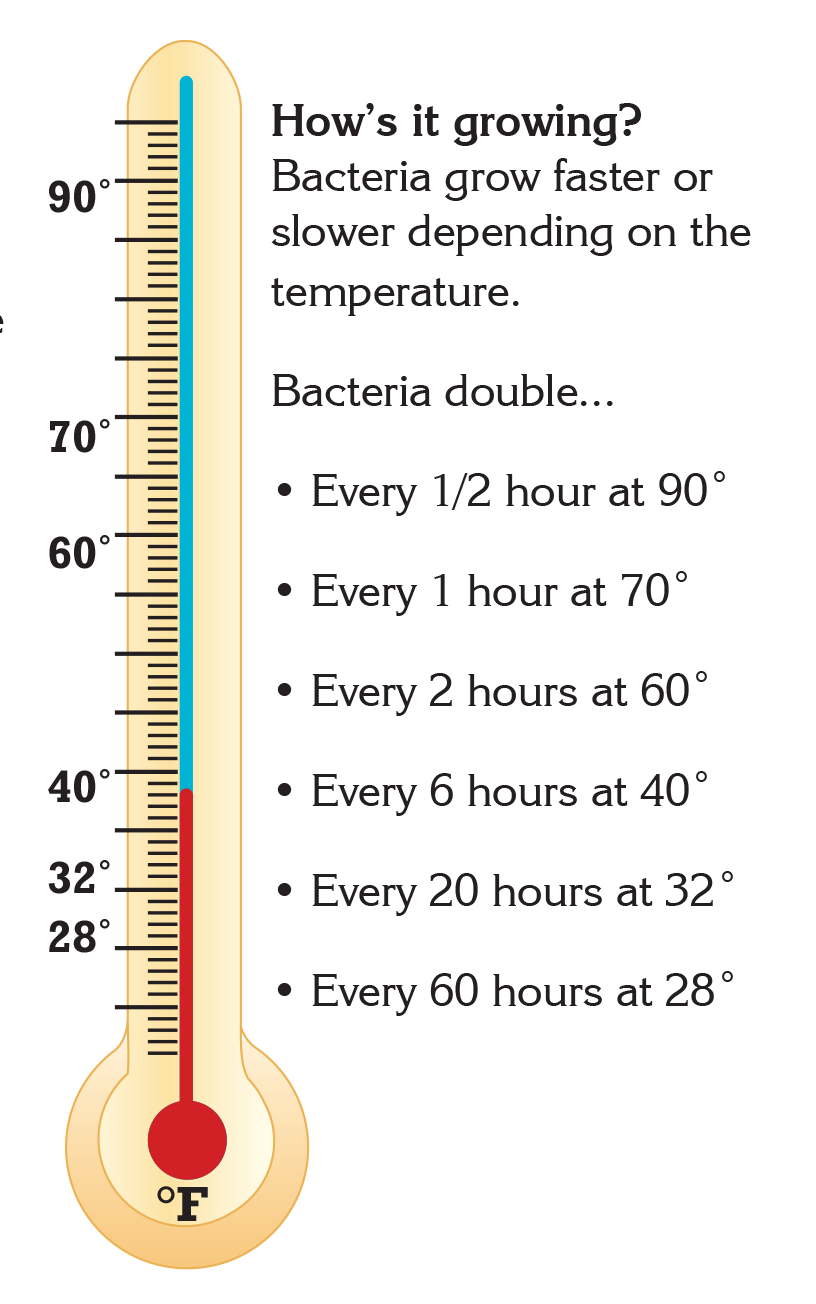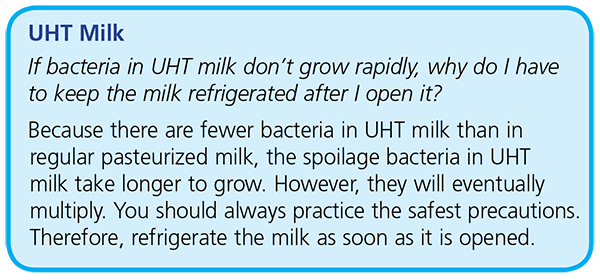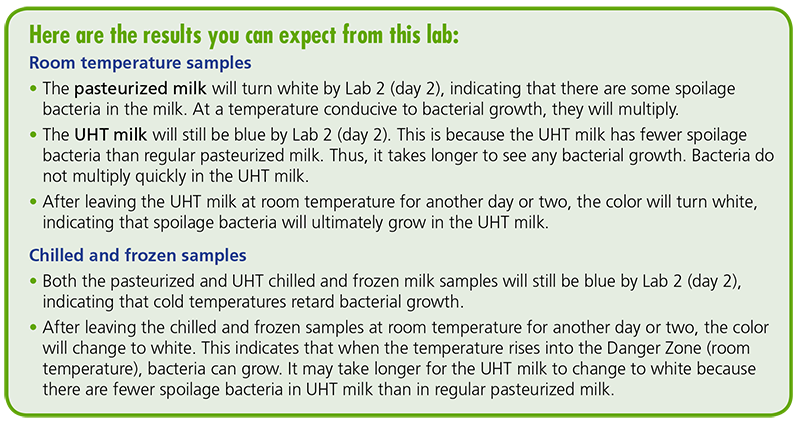Blue's the Clue: Souring Milk for Science (Grades 6-8)
This lab introduces students to the effect temperature has on reducing and controlling the growth of bacteria. Students will use conventionally pasteurized and ultra-high-temperature (UHT) milk to observe how different temperatures (hot, room temperature, cool, and freezing) affect the growth of spoilage bacteria. They will also learn about the importance of pasteurization in keeping food safe.

Background
Lesson Activities
Recommended Companion Resources
Credits
Author
Food and Drug Association (FDA) and National Science Teaching Association (NSTA)
Acknowledgements
The Science and Our Food Supply Curriculum was brought to you by the Food and Drug Administration Center for Food Safety and Applied Nutrition and the National Science Teaching Association.
- FDA Education Team Leader Food Safety Initiative: Marjorie L. Davidson
- FDA Science and Our Food Supply Project Director: Louise H. Dickerson
- FDA/NSTA Associate Executive Director and Science and Our Food Supply Program Director: Christina Gorski
- FDA/NSTA Science and Our Food Supply Program Assistant: Jill Heywood
Option B of the lab activity was adapted by Debra Spielmaker and Utah Agriculture in the Classroom.
Sources
Standards
Indiana Content Area Standards
-
English Language Arts.Grade 6.RV.1
Acquire and use accurately grade-level appropriate general academic and content-specific words and phrases; gather vocabulary knowledge when considering a word or phrase important to comprehension or expression.
- Vocabulary in Literature and Nonfiction Texts.6.RV.3.1: Determine the meaning of words and phrases as they are used in works of literature, including figurative and connotative meanings; analyze the impact of a specific word choice on meaning and tone.
-
English Language Arts.Grade 6.SL.1
Listen actively and adjust the use of spoken language (e.g., conventions, style, vocabulary) to communicate effectively with a variety of audiences and for different purposes.
- Discussion and Collaboration.6.SL.2.2: Elaborate and reflect on ideas under discussion by identifying specific evidence from materials under study and other resources.
- Discussion and Collaboration.6.SL.2.4: Pose and respond to specific questions with elaboration and detail by making comments that contribute to the topic, text, or issue under discussion.
- Presentation of Knowledge and Ideas.6.SL.4.1: Present claims and findings, sequencing ideas logically and using pertinent descriptions, facts, and details to accentuate main ideas or themes; using appropriate eye contact, adequate volume, and clear pronunciation.
-
English Language Arts.Grade 7.RV.1
Acquire and use accurately grade-appropriate general academic and content-specific words and phrases; gather vocabulary knowledge when considering a word or phrase important to comprehension or expression.
- Vocabulary in Literature and Nonfiction Texts.7.RV.3.2: Determine the meaning of words and phrases as they are used in a nonfiction text, including figurative, connotative, and technical meanings; analyze the impact of a specific word choice on meaning and tone.
-
English Language Arts.Grade 7.SL.1
Listen actively and adjust the use of spoken language (e.g., conventions, style, vocabulary) to communicate effectively with a variety of audiences and for different purposes.
- Discussion and Collaboration.7.SL.2.1: Engage effectively in a range of collaborative discussions (e.g., one-on-one, in groups, and teacher-led) on grade- appropriate topics, texts, and issues, building on others ideas and expressing personal ideas clearly.
- Discussion and Collaboration.7.SL.2.2: Investigate and reflect on ideas under discussion by identifying specific evidence from materials under study and other resources.
- Discussion and Collaboration.7.SL.2.4: Pose questions that elicit elaboration and respond to others questions and comments with relevant observations and ideas that bring the discussion back on topic as needed.
- Presentation of Knowledge and Ideas.7.SL.4.1: Present claims and findings, emphasizing salient points in a focused, coherent manner with pertinent descriptions, facts, details, and examples; use appropriate eye contact, adequate volume, and clear pronunciation.
-
English Language Arts.Grade 8.RV.1
Acquire and use accurately grade-appropriate general academic and content-specific words and phrases; gather vocabulary knowledge when considering a word or phrase important to comprehension or expression.
- Vocabulary in Literature and Nonfiction Texts.8.RV.3.2: Determine the meaning of words and phrases as they are used in a nonfiction text, including figurative, connotative, and technical meanings; analyze the impact of specific word choices on meaning and tone, including analogies or allusions to other texts.
-
English Language Arts.Grade 8.SL.1
Listen actively and adjust the use of spoken language (e.g., conventions, style, vocabulary) to communicate effectively with a variety of audiences and for different purposes.
- Discussion and Collaboration.8.SL.2.1: Engage effectively in a range of collaborative discussions (e.g., one-on-one, in groups, and teacher-led) on grade- appropriate topics, texts, and issues, building on others ideas and expressing personal ideas clearly.
- Discussion and Collaboration.8.SL.2.2: Examine, analyze, and reflect on ideas under discussion by identifying specific evidence from materials under study and other resources.
- Discussion and Collaboration.8.SL.2.4: Pose questions that connect the ideas of several speakers and respond to others questions and comments with relevant evidence, observations, and ideas.
- Presentation of Knowledge and Ideas.8.SL.4.1: Present claims and findings, emphasizing salient points in a focused, coherent manner with relevant evidence, sound valid reasoning, and well-chosen details; use appropriate eye contact, adequate volume, and clear pronunciation.

 Let teams conduct the labs according to their designs.
Let teams conduct the labs according to their designs.


